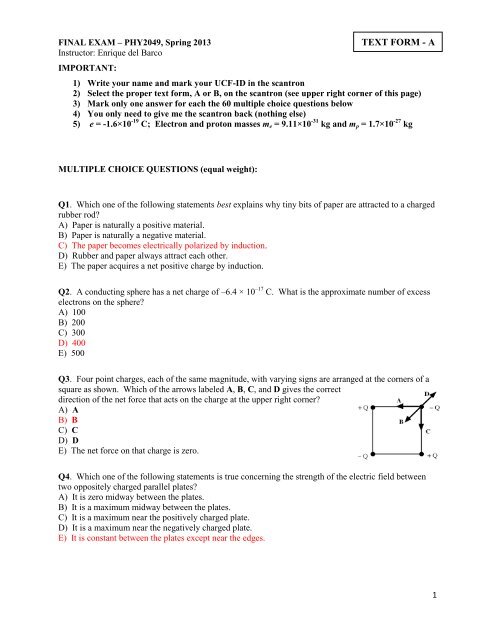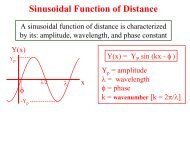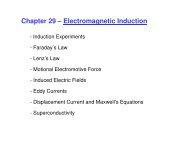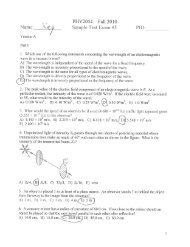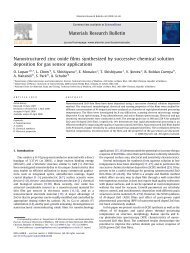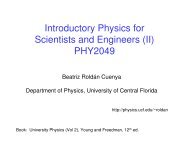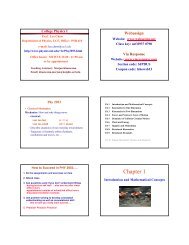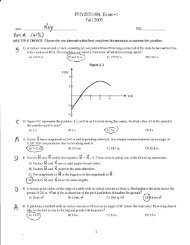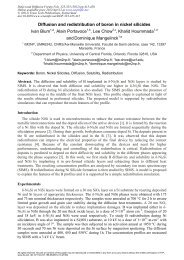TEXT FORM - A - UCF Physics
TEXT FORM - A - UCF Physics
TEXT FORM - A - UCF Physics
You also want an ePaper? Increase the reach of your titles
YUMPU automatically turns print PDFs into web optimized ePapers that Google loves.
FINAL EXAM – PHY2049, Spring 2013<br />
Instructor: Enrique del Barco<br />
IMPORTANT:<br />
<strong>TEXT</strong> <strong>FORM</strong> - A<br />
1) Write your name and mark your <strong>UCF</strong>-ID in the scantron<br />
2) Select the proper text form, A or B, on the scantron (see upper right corner of this page)<br />
3) Mark only one answer for each the 60 multiple choice questions below<br />
4) You only need to give me the scantron back (nothing else)<br />
5) e = -1.6×10 -19 C; Electron and proton masses m e = 9.11×10 -31 kg and m p = 1.7×10 -27 kg<br />
MULTIPLE CHOICE QUESTIONS (equal weight):<br />
Q1. Which one of the following statements best explains why tiny bits of paper are attracted to a charged<br />
rubber rod?<br />
A) Paper is naturally a positive material.<br />
B) Paper is naturally a negative material.<br />
C) The paper becomes electrically polarized by induction.<br />
D) Rubber and paper always attract each other.<br />
E) The paper acquires a net positive charge by induction.<br />
Q2. A conducting sphere has a net charge of –6.4 × 10 –17 C. What is the approximate number of excess<br />
electrons on the sphere?<br />
A) 100<br />
B) 200<br />
C) 300<br />
D) 400<br />
E) 500<br />
Q3. Four point charges, each of the same magnitude, with varying signs are arranged at the corners of a<br />
square as shown. Which of the arrows labeled A, B, C, and D gives the correct<br />
direction of the net force that acts on the charge at the upper right corner?<br />
A) A<br />
B) B<br />
C) C<br />
D) D<br />
E) The net force on that charge is zero.<br />
Q4. Which one of the following statements is true concerning the strength of the electric field between<br />
two oppositely charged parallel plates?<br />
A) It is zero midway between the plates.<br />
B) It is a maximum midway between the plates.<br />
C) It is a maximum near the positively charged plate.<br />
D) It is a maximum near the negatively charged plate.<br />
E) It is constant between the plates except near the edges.<br />
1
Q5. A small sphere of mass 2.5 × 10 –5 kg carries a total charge of 6.0 × 10 –8 C. The sphere hangs from a<br />
silk thread between two large parallel conducting plates. The excess charge on each plate is equal in<br />
magnitude, but opposite in sign. If the thread makes an angle of 30° with the<br />
positive plate as shown, what is the magnitude of the charge density on each plate?<br />
A) 2.5 × 10 –9 C/m 2<br />
B) 5.2 × 10 –9 C/m 2<br />
C) 1.0 × 10 –9 C/m 2<br />
D) 2.1 × 10 –8 C/m 2<br />
E) 4.2 × 10 –8 C/m 2<br />
Q6. What is the magnitude and direction of the electric force on a –3.0 µC charge at a point where the<br />
electric field is 2800 N/C and is directed along the +y axis.<br />
A) 0.018 N, –y direction<br />
B) 0.012 N, +y direction<br />
C) 0.0084 N, –y direction<br />
D) 0.0056 N, +y direction<br />
E) 0.022 N, +x direction<br />
Q7. A cubical Gaussian surface is placed in a uniform electric field as shown in the figure. The length of<br />
each edge of the cube is 1.0 m. The uniform electric field has a magnitude of 5.0 × 10 8 N/C and passes<br />
through the left and right sides of the cube perpendicular to the surface. What is the total electric flux that<br />
passes through the cubical Gaussian surface?<br />
A) 5.0 × 10 8 Nm 2 /C<br />
B) 3.0 × 10 9 Nm 2 /C<br />
C) 2.5 × 10 6 Nm 2 /C<br />
D) 1.5 × 10 7 Nm 2 /C<br />
E) zero Nm 2 /C<br />
Q8. A total charge of –6.50 µC is uniformly distributed within a sphere that has a radius of 0.150 m.<br />
What is the magnitude and direction of the electric field at 0.300 m from the surface of the sphere?<br />
A) 2.89 × 10 5 N/C, radially inward<br />
B) 6.49 × 10 5 N/C, radially outward<br />
C) 4.69 × 10 5 N/C, radially inward<br />
D) 9.38 × 10 5 N/C, radially outward<br />
E) 1.30 × 10 6 N/C, radially inward<br />
Q9. What is the electric flux passing through a Gaussian surface that surrounds a +0.075 C point charge?<br />
A) 8.5 × 10 9 Nm 2 /C<br />
B) 6.8 × 10 8 Nm 2 /C<br />
C) 1.3 × 10 7 Nm 2 /C<br />
D) 4.9 × 10 6 Nm 2 /C<br />
E) 7.2 × 10 5 Nm 2 /C<br />
2
Q10. A circular loop of wire with a diameter of 0.626 m is rotated in a uniform electric field to a position<br />
where the electric flux through the loop is a maximum. At this position, the electric flux is 7.50 × 10 5<br />
Nm 2 /C. Determine the magnitude of the electric field.<br />
A) 8.88 × 10 5 N/C<br />
B) 1.07 × 10 6 N/C<br />
C) 2.44 × 10 6 N/C<br />
D) 4.24 × 10 6 N/C<br />
E) 6.00 × 10 6 N/C<br />
Q11. Complete the following statement: The electron volt is a unit of<br />
A) energy.<br />
B) electric field strength.<br />
C) electric force.<br />
D) electric potential difference.<br />
E) electric power.<br />
Q12. Two positive point charges are separated by a distance R. If the distance between the charges is<br />
reduced to R/2, what happens to the total electric potential energy of the system?<br />
A) The total electric potential energy is doubled.<br />
B) The total electric potential energy remains the same.<br />
C) The total electric potential energy increases by a factor of 4.<br />
D) The total electric potential energy is reduced to one-half of its original value.<br />
E) The total electric potential energy is reduced to one-fourth of its original value.<br />
Q13. Which one of the following statements concerning electrostatic situations is false?<br />
A) E is zero everywhere inside a conductor.<br />
B) Equipotential surfaces are always perpendicular to E.<br />
C) Zero work is needed to move a charge along an equipotential surface.<br />
D) If V is constant throughout a region of space, then E must be zero in that region.<br />
E) No force component acts along the path of a charge as it is moved along an equipotential surface.<br />
Q14. The magnitude of the charge on the plates of an isolated parallel plate capacitor is doubled. Which<br />
one of the following statements is true concerning the capacitance of this parallel-plate system?<br />
A) The capacitance is decreased to one half of its original value.<br />
B) The capacitance is increased to twice its original value.<br />
C) The capacitance remains unchanged.<br />
D) The capacitance depends on the electric field between the plates.<br />
E) The capacitance depends on the potential difference across the plates.<br />
Q15. Which one of the following changes will necessarily increase the capacitance of a capacitor?<br />
A) decreasing the charge on the plates<br />
B) increasing the charge on the plates<br />
C) placing a dielectric between the plates<br />
D) increasing the potential difference between the plates<br />
E) decreasing the potential difference between the plates<br />
3
Q16. A capacitor is initially charged to 3 V. It is then connected to a 6 V battery. What is the ratio of<br />
the final to the initial energy stored in the capacitor?<br />
A) 3<br />
B) 5<br />
C) 6<br />
D) 7<br />
E) 9<br />
Q17. The plates of a parallel plate capacitor each have an area of 0.40 m 2 and are separated by a distance<br />
of 0.02 m. They are charged until the potential difference between the plates is 3000 V. The charged<br />
capacitor is then isolated.<br />
Determine the magnitude of the electric field between the capacitor plates.<br />
A) 60 V/m<br />
B) 120 V/m<br />
C) 1.0 × 10 5 V/m<br />
D) 1.5 × 10 5 V/m<br />
E) 3.0 × 10 5 V/m<br />
Q18. Suppose that the charges are rearranged as shown in this figure. Which one of the following<br />
statements is true for this new arrangement?<br />
A) The electric field will be zero, but the electric potential remains unchanged.<br />
B) Both the electric field and the electric potential are zero at P.<br />
C) The electric field will remain unchanged, but the electric potential will be zero.<br />
D) The electric field will remain unchanged, but the electric potential will decrease.<br />
E) Both the electric field and the electric potential will be changed and will be non-zero.<br />
Q19. Which one of the following situations results in a conventional electric current that flows<br />
northward?<br />
A) a beam of protons moves eastward<br />
B) an electric dipole moves southward<br />
C) a beam of electrons moves southward<br />
D) a beam of electrons moves northward<br />
E) a beam of protons moves northward<br />
Q20. Complete the following statement: The electromotive force is<br />
A) the maximum potential difference between the terminals of a battery.<br />
B) the force that accelerates electrons through a wire when a battery is connected to it.<br />
C) the force that accelerates protons through a wire when a battery is connected to it.<br />
D) the maximum capacitance between the terminals of a battery.<br />
E) the maximum electric potential energy stored within a battery.<br />
4
Q21. A 3.5-A current is maintained in a simple circuit with a total resistance of 1500 . What net charge<br />
passes through any point in the circuit during a thirty second interval?<br />
A) 100 C<br />
B) 180 C<br />
C) 500 C<br />
D) 600 C<br />
E) 5200 C<br />
Q22. Which one of the following combinations of units is equivalent to the ohm?<br />
A) V/C<br />
B) A/J<br />
C) J/s<br />
D) Js/C 2<br />
E) W/A<br />
Q23. Which one of the following<br />
circuits has the largest resistance?<br />
A) a<br />
B) b<br />
C) c<br />
D) d<br />
E) e<br />
Q24. When a light bulb is connected to a 4.5 V battery, a current of 0.12 A passes through the bulb<br />
filament. What is the resistance of the filament?<br />
A) 440 <br />
B) 28 <br />
C) 9.3 <br />
D) 1.4 <br />
E) 38 <br />
Q25. Determine the length of a copper wire that has a resistance of 0.172 and cross-sectional area of<br />
7.85 × 10 –5 m 2 . The resistivity of copper is 1.72 × 10 –8 m.<br />
A) 873 m<br />
B) 250 m<br />
C) 78.5 m<br />
D) 785 m<br />
E) 6570 m<br />
Q26. Which one of the following statements concerning resistors in series is true?<br />
A) The voltage across each resistor is the same.<br />
B) The current through each resistor is the same.<br />
C) The power dissipated by each resistor is the same.<br />
D) The rate at which charge flows through each resistor depends on its resistance.<br />
E) The total current through the resistors is the sum of the current through each resistor.<br />
5
Q27. A 75-W and 50-W incandescent light bulbs are designed for use with the same voltage. What is the<br />
ratio of the resistance of the 75-W bulb to the resistance of the 50-W bulb?<br />
A) 1.5<br />
B) 0.67<br />
C) 2.3<br />
D) 0.44<br />
E) 3.0<br />
Q28. Three resistors are connected as shown in the figure. The potential difference between points A and<br />
B is 26 V. Through which resistor or resistors the current will be lowest?<br />
A) 3.0 ohms<br />
B) 2.0 ohms<br />
C) 4.0 ohms<br />
D) 2.0 ohms and 4.0 ohms<br />
E) 3.0 ohms and 4.0 ohms<br />
Q29. Which one of the following statements concerning permanent magnets is false?<br />
A) The north pole of a permanent magnet is attracted to a south pole.<br />
B) All permanent magnets are surrounded by a magnetic field.<br />
C) The direction of a magnetic field is indicated by the north pole of a compass.<br />
D) Magnetic field lines outside a permanent magnet originate from the north pole and end on the south pole.<br />
E) When a permanent magnet is cut in half, one piece will be a north pole and one piece will be a south pole.<br />
Q30. Which one of the following statements concerning the magnetic force on a charged particle in a<br />
magnetic field is true?<br />
A) The magnetic force is a maximum if the particle is stationary.<br />
B) The magnetic force is zero if the particle moves perpendicular to the field.<br />
C) The magnetic force is a maximum if the particle moves parallel to the field.<br />
D) The magnetic force acts in the direction of motion for a positively charged particle.<br />
E) The magnetic force depends on the component of the particle's velocity that is perpendicular to the field.<br />
Q31. A proton traveling due west in a region that contains only a magnetic field experiences a vertically<br />
upward force (away from the surface of the earth). What is the direction of the magnetic field?<br />
A) north<br />
B) east<br />
C) south<br />
D) west<br />
E) down<br />
Q32. An electron is moving with a speed of 3.5 × 10 5 m/s when it encounters a magnetic field of 0.60 T.<br />
The direction of the magnetic field makes an angle of 60.0° with respect to the velocity of the electron.<br />
What is the magnitude of the magnetic force on the electron?<br />
A) 4.9 × 10 –13 N<br />
B) 3.2 × 10 –13 N<br />
C) 1.7 × 10 –13 N<br />
D) 3.4 × 10 –14 N<br />
E) 2.9 × 10 –14 N<br />
6
Q33. Two particles move through a uniform magnetic field that is directed out of the plane of the page.<br />
The figure shows the paths taken by the two particles as<br />
they move through the field. The particles are not subject<br />
to any other forces or fields. Which one of the following<br />
statements concerning these particles is true?<br />
A) The particles may both be neutral.<br />
B) Particle 1 is positively charged; 2 is negative.<br />
C) Particle 1 is positively charged; 2 is positive.<br />
D) Particle 1 is negatively charged; 2 is negative.<br />
E) Particle 1 is negatively charged; 2 is positive.<br />
Q34. A 0.0150-m wire oriented horizontally between the poles of an electromagnet carries a direct<br />
current of 9.5 A. The angle between the direction of the current and that of the magnetic field is 25.0° as<br />
shown. If the magnetic field strength is 0.845 T, what is the<br />
magnitude and direction of the magnetic force on the wire<br />
between the poles?<br />
A) 1.17 N, upward<br />
B) 0.330 N, downward<br />
C) 0.0509 N, upward<br />
D) 0.120 N, downward<br />
E) 0.495 N, upward<br />
Q35. Which one of the following statements concerning the magnetic field inside (far from the surface) a<br />
long, current-carrying solenoid is true?<br />
A) The magnetic field is zero.<br />
B) The magnetic field is non-zero and nearly uniform.<br />
C) The magnetic field is independent of the number of windings.<br />
D) The magnetic field is independent of the current in the solenoid.<br />
E) The magnetic field varies as 1/r as measured from the solenoid axis.<br />
Q36. A solenoid of length 0.250 m and radius 0.0250 m is comprised of 440 turns of wire. Determine<br />
the magnitude of the magnetic field at the center of the solenoid when it carries a current of 12.0 A.<br />
A) 2.21 × 10 –3 T<br />
B) 4.52 × 10 –3 T<br />
C) 9.05 × 10 –3 T<br />
D) 7.50 × 10 –3 T<br />
E) zero tesla<br />
Q37. A long, straight wire carries a current I. If the magnetic field at a distance d from the wire has<br />
magnitude B, what is the magnitude of the magnetic field at a distance 2d from the wire?<br />
A) B/2<br />
B) B/4<br />
C) 2B<br />
D) 4B<br />
E) 8B<br />
7
Q38. A coil of wire carries current I as shown in the figure on the right. If the observer could “see” the<br />
magnetic field inside this arrangement of loops, how would it appear?<br />
A) a<br />
B) b<br />
C) c<br />
D) d<br />
E) e<br />
Q39. A long, straight wire is carrying a current of 5.0 A in the direction shown in the figure. The point P<br />
is 0.040 m from the wire. What is the direction of the<br />
magnetic field at point P due to the current in the wire?<br />
A) to the right of page<br />
B) to the left of the page<br />
C) toward the bottom of the page<br />
D) into the plane of the page<br />
E) out of the plane of the page<br />
Q40. A conducting loop of wire is placed in a magnetic field that is normal to the plane of the loop.<br />
Which one of the following actions will not result in an induced current in the loop?<br />
A) Rotate the loop about an axis that is parallel to the field and passes through the center of the loop.<br />
B) Increase the strength of the magnetic field.<br />
C) Decrease the area of the loop.<br />
D) Decrease the strength of the magnetic field.<br />
E) Rotate the loop about an axis that is perpendicular to the field and passes through the center of the loop.<br />
Q41. A conducting bar moves to the left at a constant speed v on two conducting rails joined at the left as<br />
shown. As a result of the bar moving through a constant magnetic field, a current I is induced in the<br />
indicated direction. Which one of the following directions is that of<br />
the magnetic field?<br />
A) toward the right<br />
B) toward the left<br />
C) parallel to the long axis of the bar<br />
D) into the page<br />
E) out of the page<br />
8
Q42. A long, straight wire is in the same plane as a rectangular, conducting loop. The wire carries a<br />
constant current I as shown in the figure. Which one of the following statements is<br />
true if the wire is suddenly moved toward the loop?<br />
A) There will be no induced emf and no induced current.<br />
B) There will be an induced emf, but no induced current.<br />
C) There will be an induced current that is clockwise around the loop.<br />
D) There will be an induced current that is counterclockwise around the loop.<br />
E) There will be an induced electric field that is clockwise around the loop.<br />
Q43. Two conducting loops carry equal currents I in the same direction as shown in the figure. If the<br />
current in the upper loop suddenly drops to zero, what will happen to the current in<br />
the lower loop according to Lenz's law?<br />
A) The current in the lower loop will decrease.<br />
B) The current in the lower loop will increase.<br />
C) The current in the lower loop will not change.<br />
D) The current in the lower loop will also drop to zero.<br />
E) The current in the lower loop will reverse its direction.<br />
Q44. The figure shows a circular, conducting loop that is connected to a 5.0-V battery and a switch S.<br />
Immediately after the switch S is closed, the current through the loop changes at a rate of 15 A/s and the<br />
emf induced in the loop has a magnitude of 5.0 V. Determine the selfinductance<br />
of the coil.<br />
A) 0.33 H<br />
B) 0.60 H<br />
C) 1.5 H<br />
D) 3.0 H<br />
E) 5.0 H<br />
Q45. Two coils share a common axis as shown in the figure. The mutual inductance of this pair of coils<br />
is 6.0 mH. If the current in coil 1 is changing at the rate of 3.5<br />
A/s, what is the magnitude of the emf generated in coil 2?<br />
A) 5.8 × 10 –4 V<br />
B) 1.7 × 10 –3 V<br />
C) 3.5 × 10 –3 V<br />
D) 1.5 × 10 –2 V<br />
E) 2.1 × 10 –2 V<br />
Q46. An ac voltage source that has a frequency f is connected across the terminals of a capacitor. Which<br />
one of the following statements correctly indicates the effect on the capacitive reactance when the<br />
frequency is increased to 4f?<br />
A) The capacitive reactance increases by a factor of four.<br />
B) The capacitive reactance increases by a factor of eight.<br />
C) The capacitive reactance is unchanged.<br />
D) The capacitive reactance decreases by a factor of eight.<br />
E) The capacitive reactance decreases by a factor of four.<br />
9
Q47. Three 4.0-µF capacitors are connected in parallel across the terminals of a 60.0-Hz generator.<br />
What is the capacitive reactance of the circuit?<br />
A) 39 <br />
B) 110 <br />
C) 330 <br />
D) 660 <br />
E) 1.0 × 10 3 <br />
Q48. Which one of the following<br />
phasor models correctly represents a<br />
circuit comprised of only an inductor<br />
and an ac generator?<br />
A) a<br />
B) b<br />
C) c<br />
D) d<br />
E) e<br />
Q49. Complete the following statement: When the current in an oscillating LC circuit is zero,<br />
A) the charge on the capacitor is zero.<br />
B) the energy in the electric field is maximum.<br />
C) the energy in the magnetic field is a maximum.<br />
D) the charge is moving through the inductor.<br />
E) the energy is equally shared between the electric and magnetic fields.<br />
Q50. Use the information given in the figure for the series RCL circuit to determine its total impedance.<br />
A) 300 <br />
B) 500 <br />
C) 1500 <br />
D) 1700 <br />
E) 1900 <br />
Take care, my wonderful engineers. And by the way,<br />
if any of you ends designing planes, please make<br />
wider coaches… (I keep requesting this every<br />
semester but it has not worked out yet)<br />
Enrique<br />
10


